Introduction
You are on a website that is entirely dedicated to shungite stone. My name is Eugene; I was born and raised in the Republic of Karelia, Russia.
For more than ten years, I have been interested in studying various rocks and stones in my region. One of the most exciting stones for me was shungite. In this article, I will explain what shungite is.
To create this article, we (I and my team) used a lot of scientific literature from various Russian scientists and Geologists. You will find a list of this literature at the end of this article.
A note from the author
After reading this article, you will get the most complete picture of shungite stone. For example, you will learn the actual scientific definition of this rock. Get to know all types of the Russian Stone. You will learn the features of the chemical composition. I also get you a information about its use, advantages, and properties.
This article turned out to be a little more than the author expected. However, a patient reader who has decided to learn more about shungite stone will get a complete picture of this rare Russian stone.
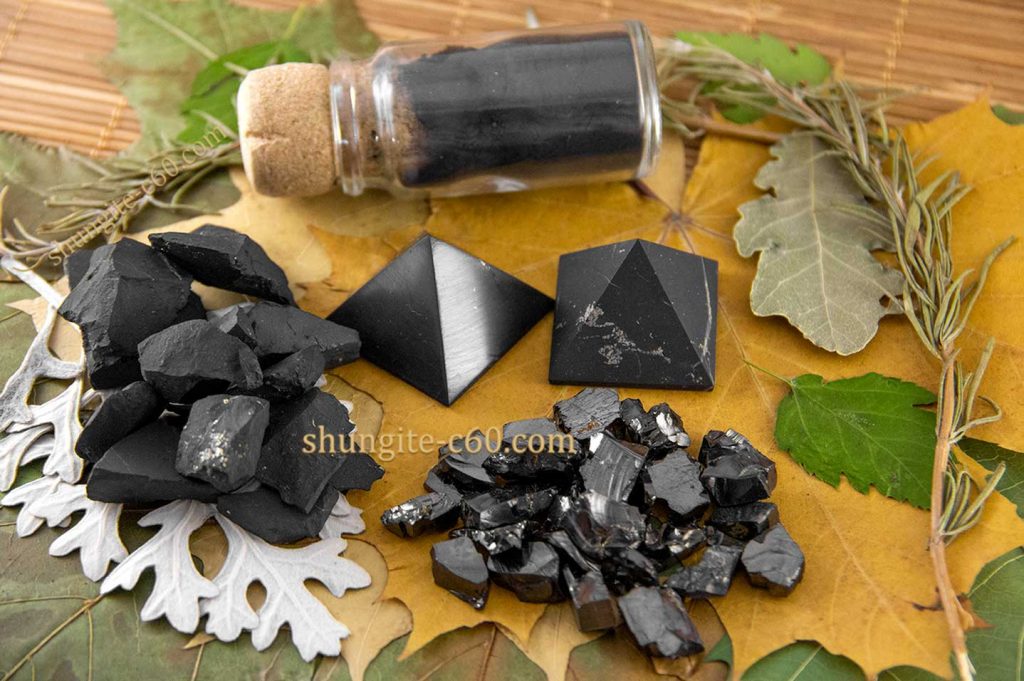
It is also important to note that our article was originally written in Russian. After that, we translated this article into English. In this case, we relied only on our strength, an online translator’s help, and our English knowledge.
Therefore, there is a high probability that you may notice some grammatical or spelling errors throughout this article. Please let us know about the bugs you have seen so we can fix them. This way, you will be able to contribute to the development and improvement of this article.
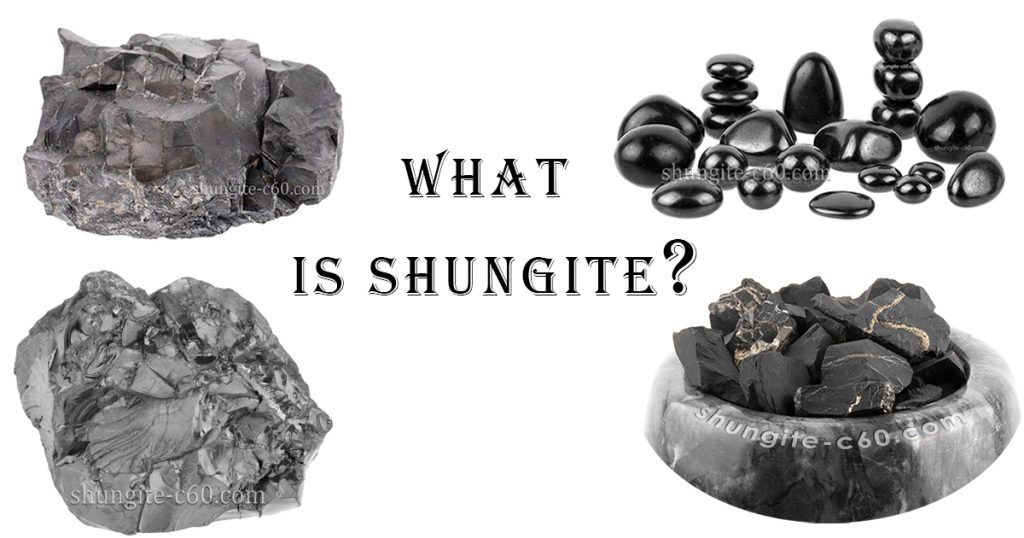
Table of contents:
- Scientific definition
- The main features
- Where is it found?
- Carbon
- Fullerenes
- What is fullerenes c60
- Types
- Pyrite and Quartz
- Souvenir products
- Chemical composition
- Properties
- Fakes
- Certification
- EMF protection
- Conclusion
What is shungite: Scientific definition
Shungite is an extremely rare, naturally occurring, non-crystalline mineraloid with a unique molecular structure. The main element is fullerene substance, an amorphous form of Carbon.
The main difference of this Russian rock is the high content of amorphous Carbon (fullerene) in the chemical composition. In addition, the features of shungite are also characterized by its unusual properties and unique chemical structure.
Most types of rocks are present in all corners of our planet. On the contrary, mountain deposits of shungite have been discovered in only one region: the Republic of Karelia in northern Russia. According to various scientific estimates, it has a colossal age of several billion years. This indicates a complex interaction of biological and geological processes during its formation, potentially related to the decomposition of organic substances such as seaweed.
Main types depending on carbon content
In the scientific community, shungite is divided into three categories. Each category has its color and amount of carbon content. The higher the percentage of Carbon, the more gray and shiny the rock’s surface will be.
For example, black stones are type 3 and have 32% carbon. The second type has about 60% carbon, a gray color, and a matte, non-reflective surface.
The rarest and most beautiful type 1, also called elite, has the most significant amount of Carbon, up to 98%. As a result, type 1 has a curvy, shiny silver color that reflects light well. However, it is worth noting that if there is no bright lighting, the surface of this mineral will not shine but will have a gray color.
The physical properties of shungite stone also vary depending on the presence of other minerals in its chemical composition. Below is a complete table of all the minerals and chemical elements that make up this rare rock.
It is also important to note that the presence of fullerenes in this rock gives it unique physical and chemical properties inaccessible to other minerals or rocks.
The main features of Shungite rocks
Fullerenes
The presence of Fullerenes in the chemical composition of shungite stone rightfully gives it the rarest and most unusual mineral in the world. The fact is that fullerenes (allotropic molecular forms of Carbon) have been found only in the chemical composition of this rock.
Key Features
This rare Russian rock has beneficial and rare properties that will be useful not only for humans but also for the environment. Here is a short list of the leading and most valuable properties:
- The ability to purify and disinfect water. Similar sorption and antibacterial properties are not found in other rocks. The most effective in this area is the black shungite, which is the third type.
- Absorption of high-frequency electromagnetic waves, the sources of which are various household appliances. The definition of these harmful waves can often be found in the abbreviation EMF. Many people are skeptical about this ability, but this fact has been scientifically proven. In addition, many studies, experiments, and tests in open sources confirm this. Type 3 has also become the object of these scientific studies.
- The ability to mineralize and saturate the water with fullerenes. This complex molecular form is recognized as one of the most potent natural antioxidants. Type 1 (elite) shungite stone is recognized as the most effective in this area. It has the highest percentage of Carbon, approximately 98%.
At this stage, you have received the most basic, brief ideas and got acquainted with shungite. We also learned about its main features. But it’s too early to stop. Next, we invite you to get to know this rock as closely as possible.
Where is shungite found?
Deep within the Karelia region of Russia lies the birthplace of shungite, a mineral that has mystified scientists and geologists and captivated enthusiasts worldwide. This ancient rock formation has an intriguing origin story, contributing to its rarity and allure.
Shungite stone was first discovered in the small village of Shunga, from which it derived its name. Deposits of this extraordinary mineral are primarily found in the Zazhoginsky and Shunginsky areas, nestled amidst the vast wilderness of the Karelian landscape.
Nature crafted the rarest rock deposit in the world here amidst the pristine forests and tranquil lakes. This scarce rock is found only in one place on Earth: the North-Western region of Russia, the “Republic of Karelia.”
The Russian black stone is a mineral whose main chemical element is Carbon. Most noteworthy, only this form of Carbon contains natural Fullerenes. This mineral has unique and unusual properties no longer inherent in any mineral on Earth. According to scientific research, it was formed over two billion years ago.
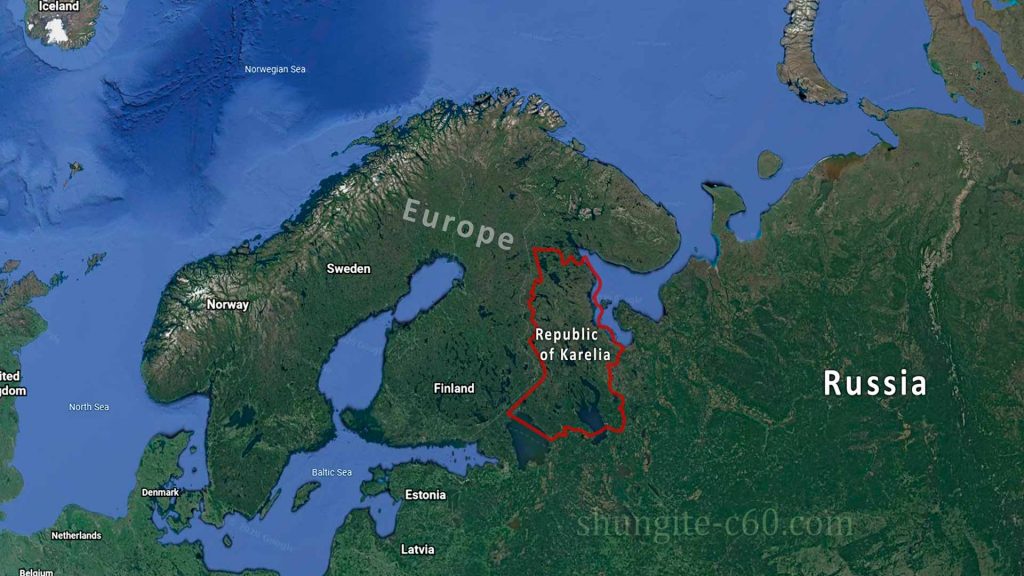
Notably, in the Karelian region, outcrops of different shungite rocks are on the Earth’s surface. At the same time, the most famous deposit of the classic black variety is the Zazhoginsky deposit (or it is called Zazhoginsky, Zazhogino). The black rock with the most constant characteristics is mined in this place. We also produce various products from it.
Why is shungite stone considered rare?
The answer lies in its unique composition and formation process. Shungite is predominantly composed of Carbon, which distinguishes it from other rocks and minerals. However, the presence of fullerenes sets the Russian black stone apart, a specific arrangement of carbon molecules that form hollow spheres, tubes, or ellipsoids.
What makes shungite electrically conductive?
All three types of shungite rock can conduct electric current. Use any multimeter to check this. The presence of an amorphous form of Carbon in the composition of Russian rock is the reason for this phenomenon. This helpful property has directed scientific and technical laboratories to create various technological applications, such as batteries and electronics.
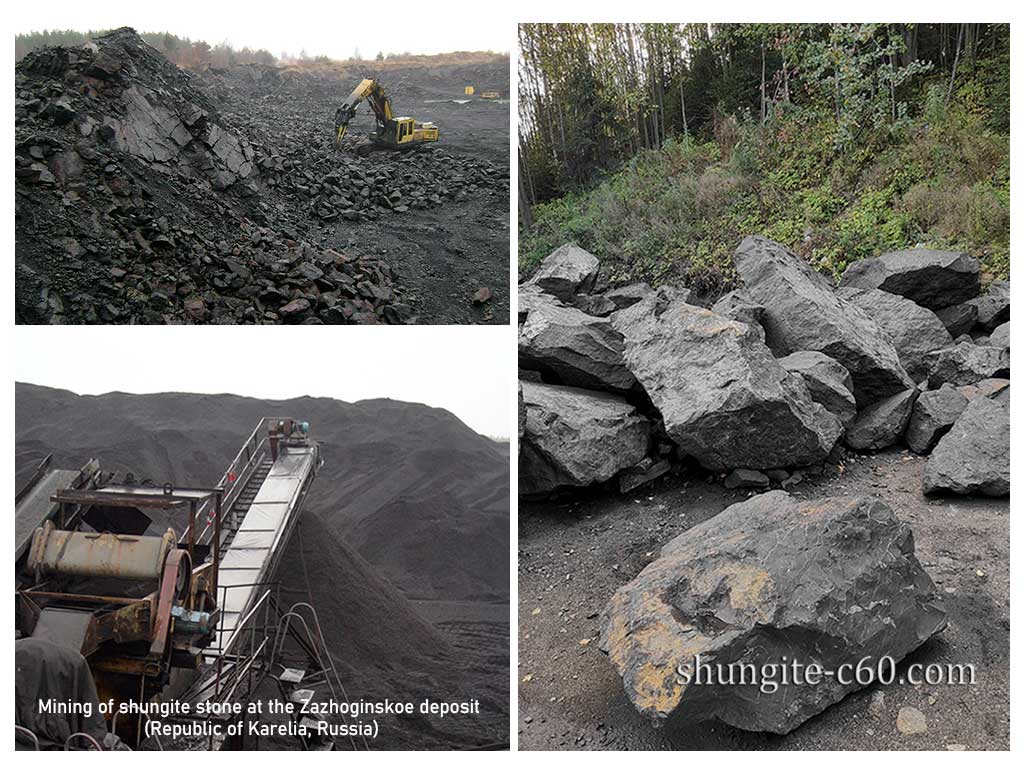
Shungite Carbon
Carbon is a chemical element discovered by French scientist Antoine Lauren, who founded the modern science of Chemistry. At its discovery, carbon was called “clean coal.” In 1780, carbon appeared in the book Method of Chemical Nomenclature.
After that, the concept of “Clean coal” was changed to Carbon. Carbon is a chemical element that exists in many allotropic modifications. In modern science, there is a concept of “Allotropic modifications of carbon, ” a substance similar in composition but different in chemical structure.
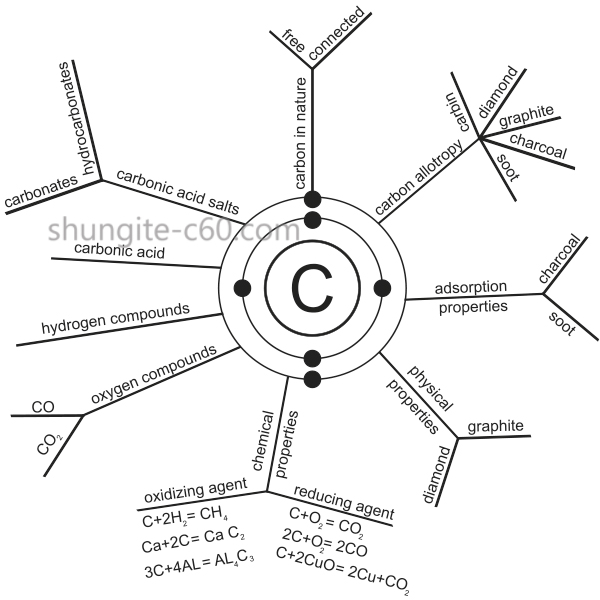
Fullerenes in Shungite Stone
Shungite, the remarkable carbon-based mineral, intrigues scientists and enthusiasts alike. One key factor contributing to its uniqueness is the presence of fullerenes, molecular structures that have revolutionized the world of chemistry. Let’s delve into the significance of fullerenes in the rock and their fascinating properties.
The Russian stone is a rare natural source of fullerenes, which has aroused the scientific community’s interest. Similar molecular compounds have not been found in any other substance.
These carbon structures are also known as “Globules.” They are the reason for the unique properties of shungite. Currently, scientists have managed to find another source of fullerenes, but this source is artificial.
If you are interested in fullerenes and want to learn more about this molecular structure, please read this article.
Types of Shungite: Classifications
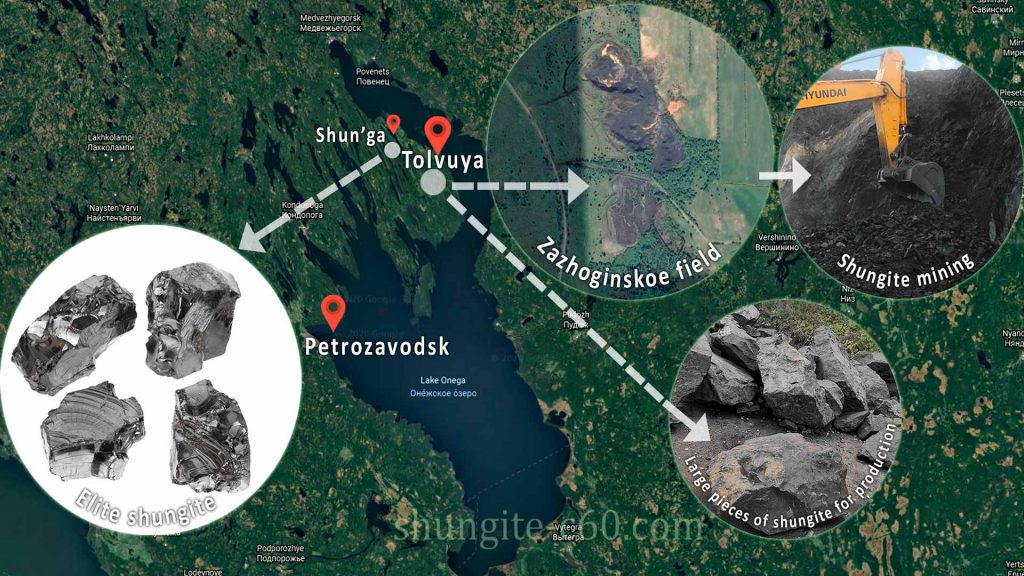
Type 3: Regular
First, we will look at the most common type: shungite, which is black and looks like coal. This type is classified as type 3, classic, or regular. Scientists have become fascinated with this black stone worldwide.
This black mineral is very amenable to processing and is best suited for manufacturing various souvenir products. In addition, if we talk about the ability to purify water and protect it from electromagnetic waves of different frequencies, we will mean this particular black mineral type 3.
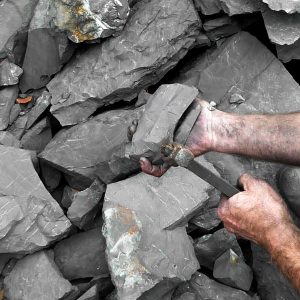
On the territory of Karelia, there are many different shungites. For their classification, a simple scheme of carbon content in the rock is used (P. A. Borisov). However, there are other ways of classifying these ancient Precambrian rocks from other researchers, which more fully reflect the idea of the breed. They consider rocks in terms of chemical composition, history, and formation conditions.
In addition, the very scientific definition of Russian rock has changed over time and among different researchers. Moreover, scientists may call it a rock or a mineraloid, depending on its carbon content, but not a gem.
Type 2: Petrovsky
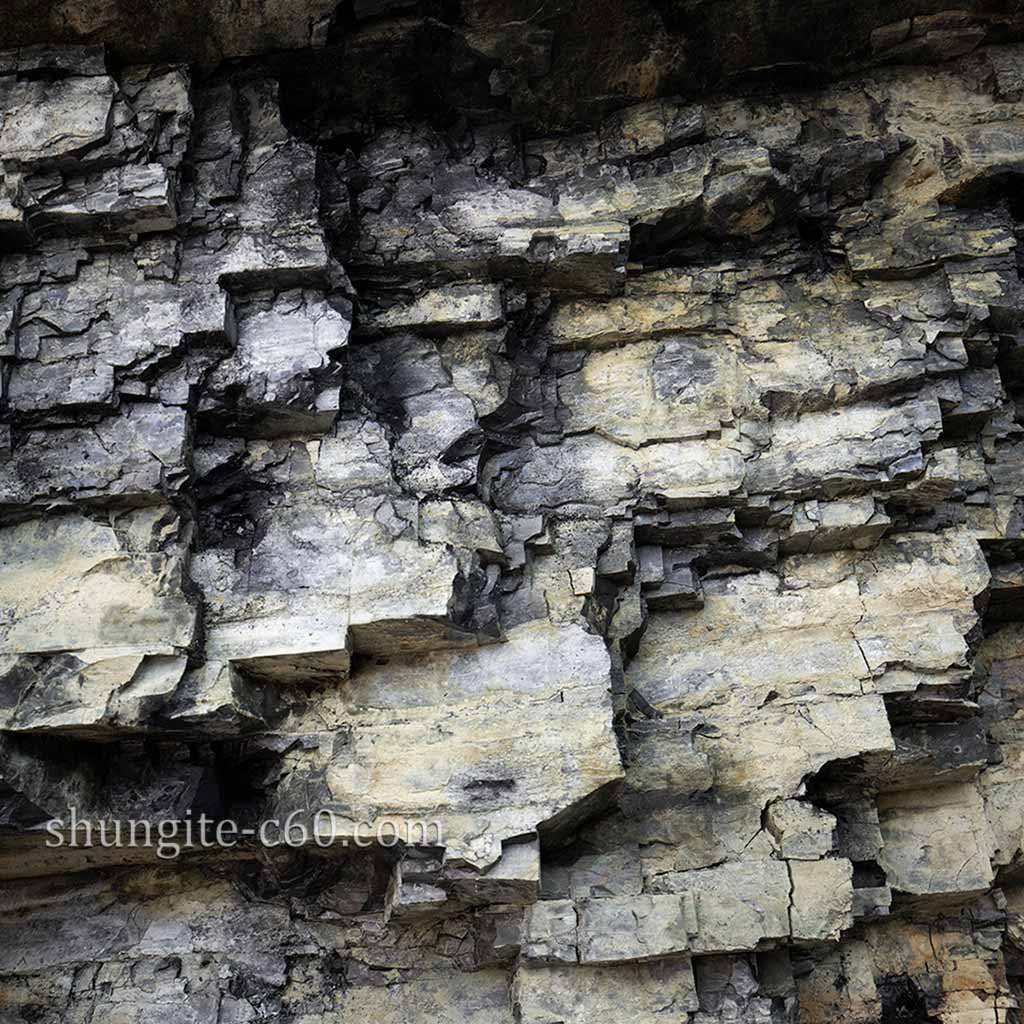
Petrovsky shungite occurs at the Shunga deposit and contains 35-75% of the unique Carbon. This type of mineral is in the middle between the first and third types regarding the reserve amount. So its reserves are much less than a stone type 3 but more than that of type 1.
Type 2 rock has a gray matte, low-gloss graphite color, and parallelepiped jointing. The photo shows that the gray stone is, as it were, divided into rectangles or cubes. These external characteristics reminded geologists of anthracite. Therefore, at first, they called this shungite “Onega anthracite” (after the name of Lake Onega).
Due to its external resemblance to anthracite coal, the study of the rock in the Russian Empire began intensively in 1877. However, it turned out that the Russian black stone is not coal and is economically unwise for heating furnaces.
An important fact is that we do not process Petrovsky minerals to produce rock products in Karelia. We and other production facilities cannot process them on an industrial scale and make products from them because of the physicochemical properties of type 2. In addition, we know that the reserves of the gray stones of the second type are tiny. Therefore, we now offer nuggets of the Petrovsky mineral type only for collections.
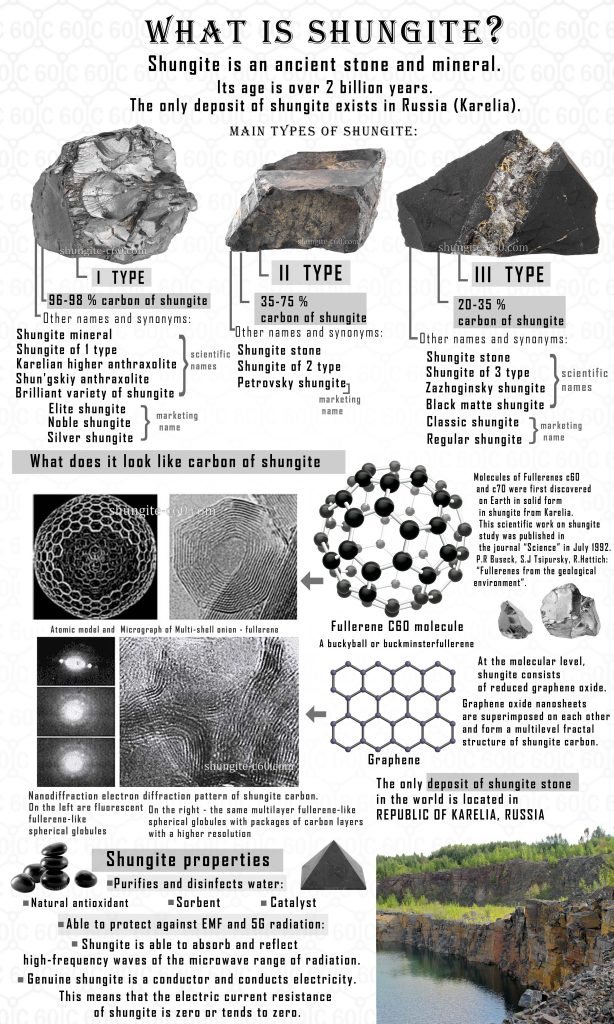
Type 1: Elite Silver rock
Finally, it is a silver type 1 of shungite, thanks to which this rare Karelian rock has become known worldwide. Scientists call this type of shungite stone type 1. Also, on the Internet, sellers call it “elite” or noble.
First, I want to note that it is almost pure, unique Carbon (98-99%). The structure of this Carbon is very similar to the carbon structure of the meteorite Alland. Until now, there have been no exact scientific explanations about the origin of type 1.
Also, the carbon form of this rare mineral has nothing to do with other forms of Carbon on Earth. Some scientists have suggested that this unique mineral could be sent to Earth from space. However, other scientists believe silver shungite is a stone of terrestrial origin. Silver rock type 1, or the black type of the three types, was formed over millions and billions of years.
What does type 1 Shungite stone look like?
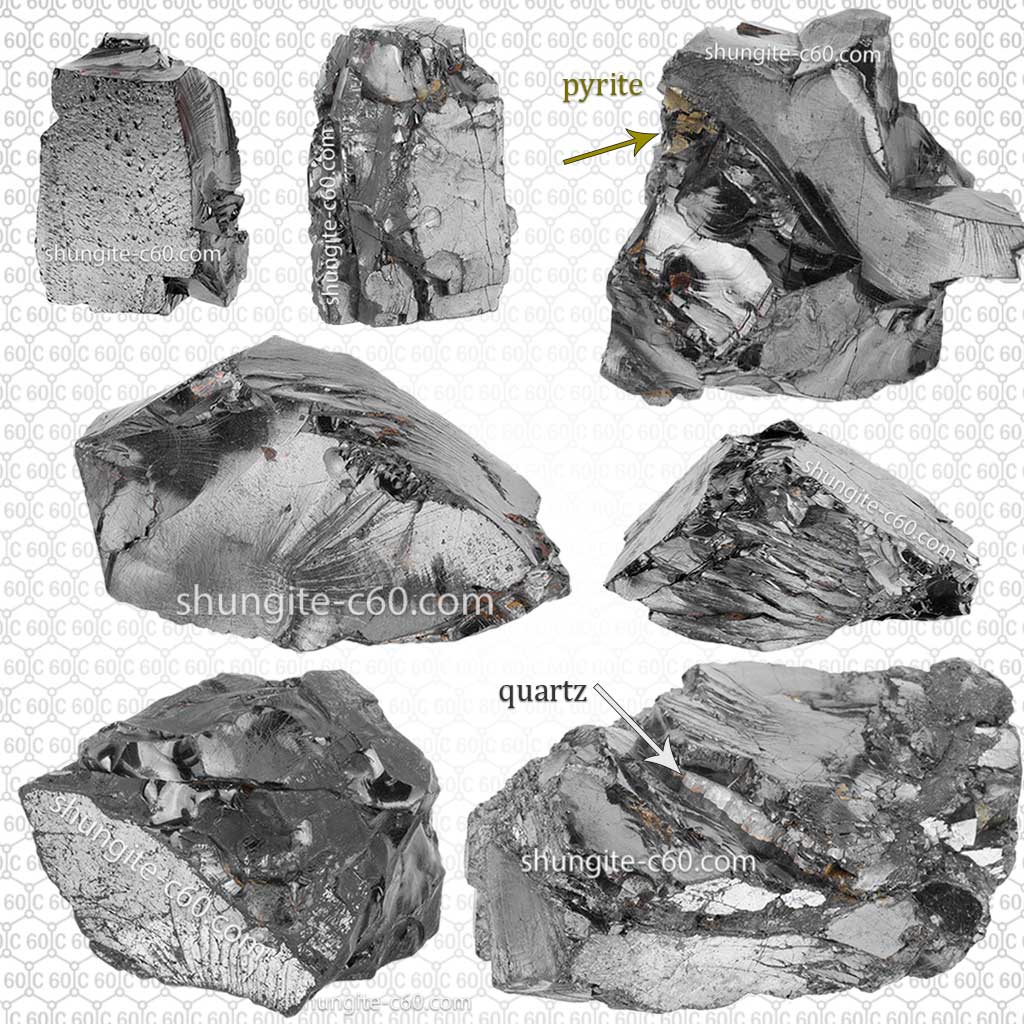
Shungite stone type 1 is silver-gray; its surface is smooth to the touch and reflects light. Meanwhile, a slight inclusion of a satellite mineral can also be seen on its surface. Above all, other minerals that are part of the present Elite type can give traces of rust on their surface.
For exampPyrite. It can leave traces of rust when oxidized on oxygen. It would be best not to fear this phenomenon because rust is a natural feature of the silver mineral. However, you can clean the rare mineral with a stiff brush and water. Please see what genuine elite rocks look like in our elite Type 1 section.
Type 1: Rock Deposit
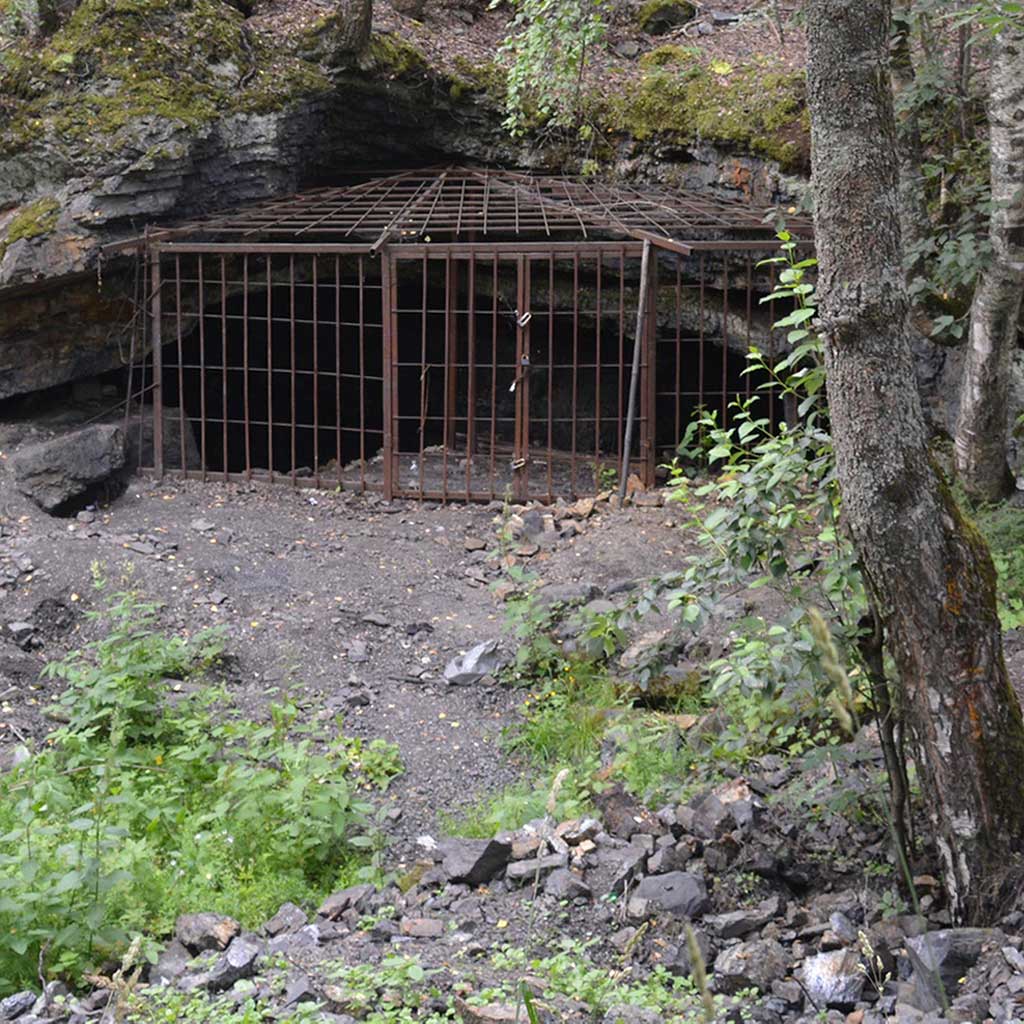
It is an extremely rare mineral. Indeed, back in the days of the USSR, a mining enterprise practically exhausted the first type of shungite resource. The name of the mineral is consonant with the village of Shun’ga, where it was first found. Currently, each piece is extracted by hand. Shortly, this unique and one of the rarest and most helpful minerals will cease to exist in the natural environment. Learn more about silver Russian stone type 1 ←(click here)
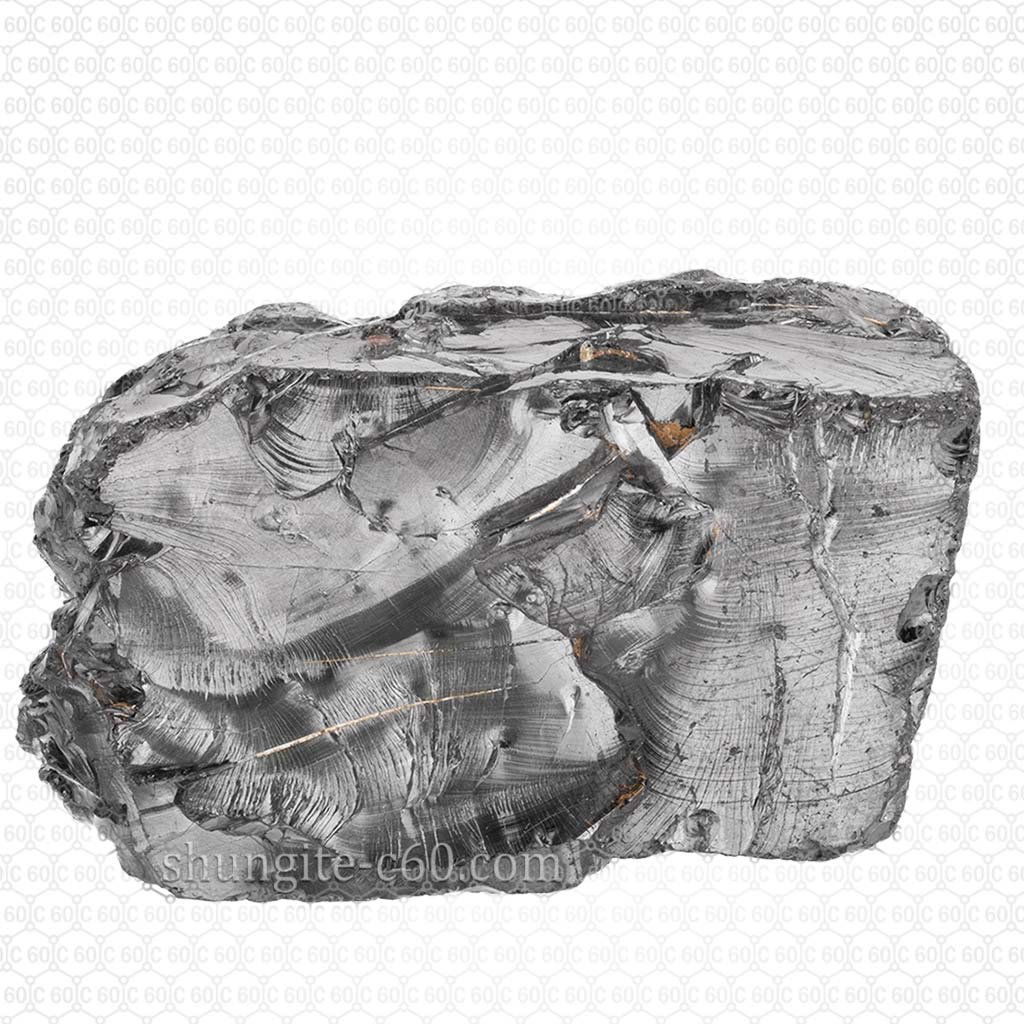
Please note that this rare silver elite mineral is the rarest of all three types. We extracted every piece of the noble silver stone ourselves. See how real type 1 shungite stones look in our collection. I guarantee that you will receive only authentic stones from Karelia from us. In addition, we are located directly in the Republic of Karelia and personally create all the products for our store. Therefore, you can receive only genuine products from rare Russian stones from us. Lately, we have been making even faster deliveries. Our catalog shows the entire range of natural samples of the Russian silver stone 98% carbon.
Shungite stone from Colombia
Any minerals from Colombia cannot be attributed to authentic shungite stones. This mineral is mined in Colombia, similar to type 1 silver rock. The Colombian stone is an anthracite but not a higher anthraxolite. This mineral is not shungite. However, because of the similarity with silver Russian minerals, specialists often confuse them even during visual inspection.
You can use an electrical conductivity test to identify fake rocks from Colombia. The values on the multimeter for Colombian stones will be 15 or higher, indicating this mineral’s inferior electrical conductivity ability. On the contrary, Russian rock type 1 has a value close to zero. You can learn more about fakes from Colombia in this article.
Pyrite and Quartzite in Shungite Stone
The black Russian stone has interesting companions within its geological formation. Two commonly encountered minerals in the black rock structure are Pyrite and Quartz. Let’s delve into the significance of Pyrite and Quartz in the context of shungite and the unique characteristics they bring to this intriguing mineral.
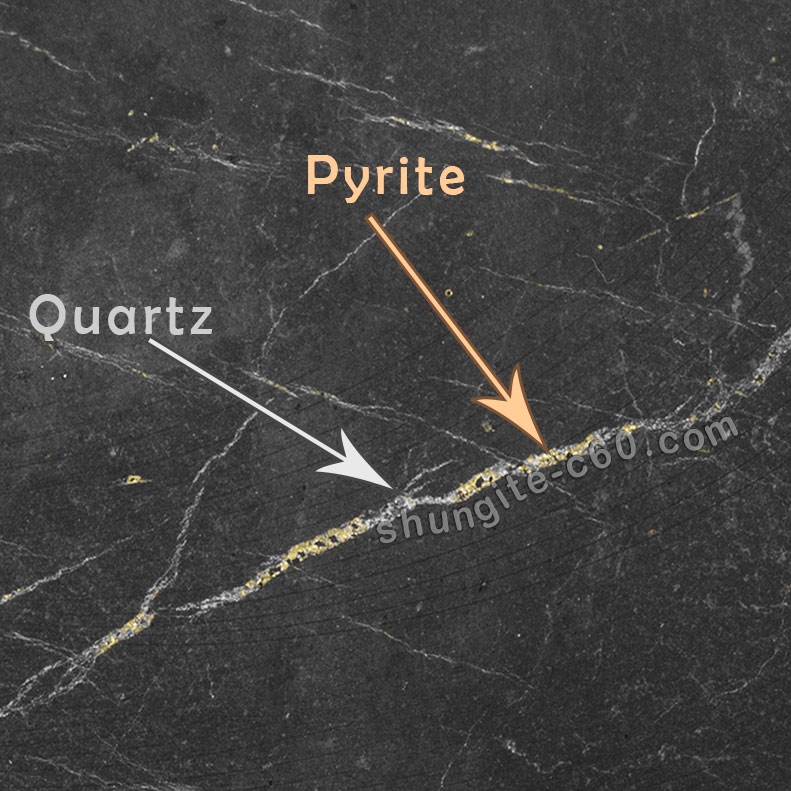
Pyrite in Shungite
Pyrite is a compound of iron and sulfur. It is yellow and looks a bit like gold. This mineral is notable because in the structure of shungite, like Quartz, it occurs in the form of veins. Such streaks are often confused with scratches, especially if they are visible on souvenirs. For example, on engraved pendants made of shungite stone. The veins of Pyrite give each stone or product its uniqueness. After all, these patterns never have repetitions.
In addition to its visual appeal, Pyrite has metaphysical properties like any mineral. It is believed that it has protective properties and protects against negative energy. Pyrite products are used as a symbol of prosperity and good luck.
Quartz
Quartz is a hard mineral that can be in many colors and shades. It is one of the most commonly found minerals on Earth. It can be transparent or have a milky shade impervious to light. Due to the contrast of white Quartz on the black surface of shungite, jewelry and decorative products have a beautiful, harmonious appearance.
It is worth noting that Quartz does not conduct electric current. Therefore, tests for the electrical conductivity of shungite are sometimes incorrect. The measurement area passes through the veins of Quartz. Like Pyrite, Quartz permeates the entire structure of Russian rock in veins similar to scratches.
The beauty and uniqueness of the natural pattern
Pyrite and Quartz coexist with shungite stone, creating an intriguing synergy of energies and aesthetics. Combining protective and purifying properties, Pyrite’s abundance and prosperity symbolism and Quartz’s amplifying and clarifying qualities can make for a potent combination.
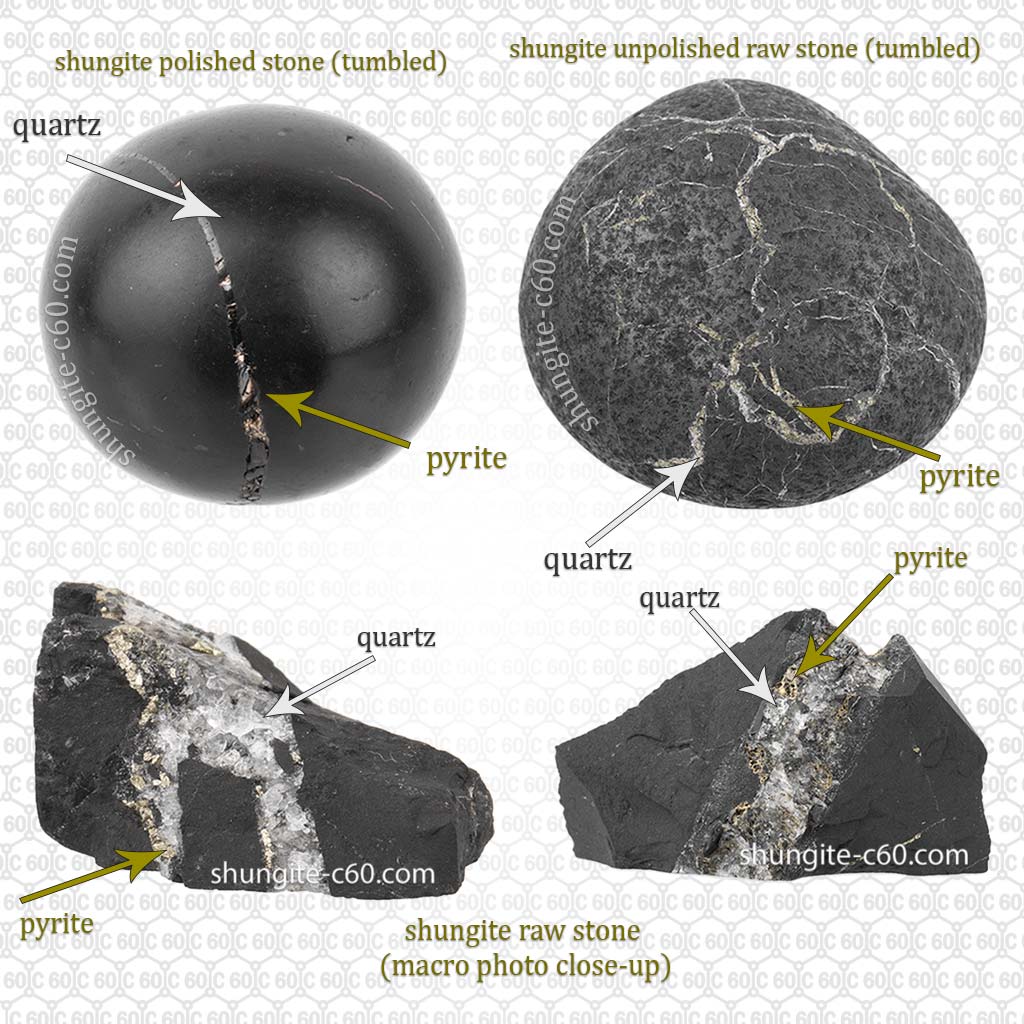
It’s worth noting that the presence and composition of Pyrite and Quartz in shungite stone can vary. Some rock deposits may have higher concentrations of these minerals, while others may have less pronounced occurrences. These minerals’ specific characteristics and effects within the black rock are subjects of ongoing exploration and personal experience.
Shungite stone with a characteristic pattern of Quartz and Pyrite
For example, we make different pendants of a unique geometric shape from the third type variety. We also engrave our round pendants. Of course, the natural distinctive characteristics of the black shungite with marks of Quartz and Pyrite are also proof of the authenticity of our pendants. We polish our pendants to make them look shiny. Unlike fake black pendants, our Karelian stone pendants are safe for the skin.
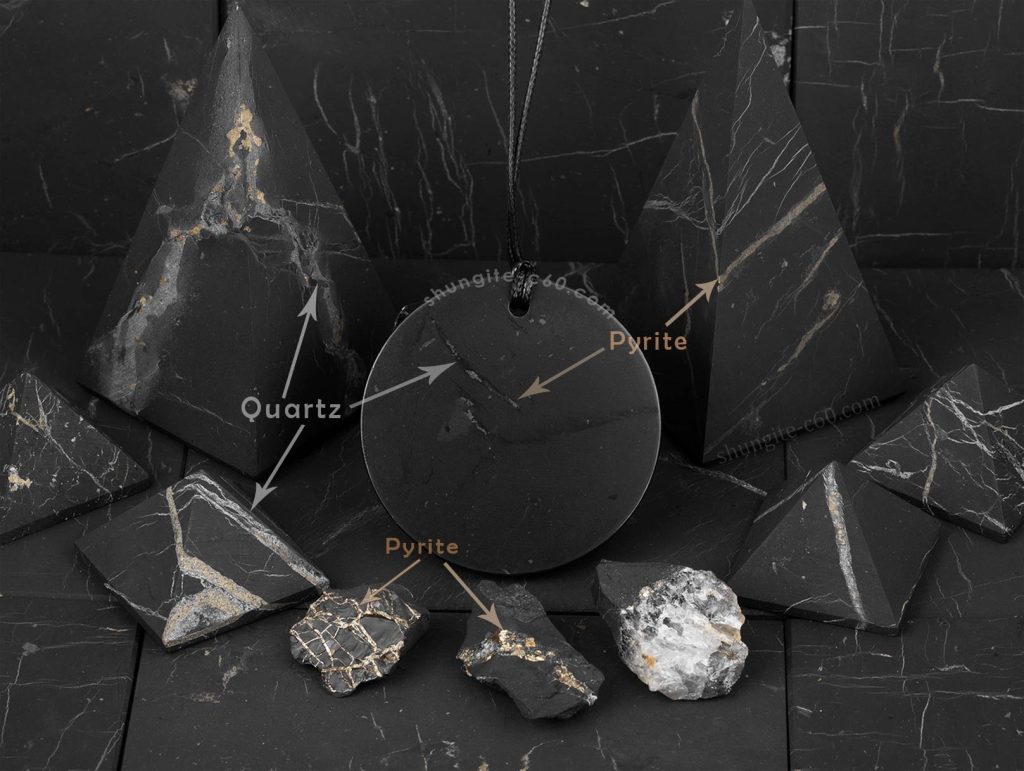
That makes Karelian rare black stone different from similar rocks mined in many countries. Other rocks are called “carbon-containing.” It does not contain fullerenes, and there is no unique carbon C60. Such minerals are very cheap for sale and do not have unique properties. Very often, such only superficially similar rocks can be very advantageously passed off as a real Karelian shungite stone. After discovering this ancient black mineral’s unique, helpful properties, its forgeries became too much.
Features of Shungite products
The scarcity of shungite has sparked immense interest and demand, especially in recent years. Its reputation as a natural healer, water purifier, and electromagnetic radiation shield has elevated its status in wellness and holistic health communities. The rare and ancient Nature of shungite stone only adds to its mystique and allure, making it a prized possession for those seeking balance and harmony.

The main feature of genuine shungite products is the presence of two minerals, Pyrite and Quartz. The veins of these two minerals can be seen on the surface of the black stone products. This is a distinctive and visually noticeable feature that distinguishes authentic Russian minerals from fakes.
We produce an extensive range of souvenirs of various geometric shapes: pyramids, spheres, cubes, plates for phones, pendants, harmonizers, tableware, and more.
Premium quality but unnatural fake stone
We know other sellers use stamped factory molds and a mixture of shungite stone dust, resin, and other impurities. Their products look perfect and have fantastic proportionally smooth sides. But is this a real natural Russian rock? No, it’s a pressed stamped product made of black resin, orgonite, adhesive composite materials, and plastic powder.
We have been manufacturing our products for more than five years, and our mission is to make products from natural shungite only. But we still strive to improve the technique and skill of stone cutting. Our products are hand-cut from solid pieces of raw Karelian black rock.
We constantly strive for the result so that our products are beautiful and, simultaneously, made by hand from natural stone.
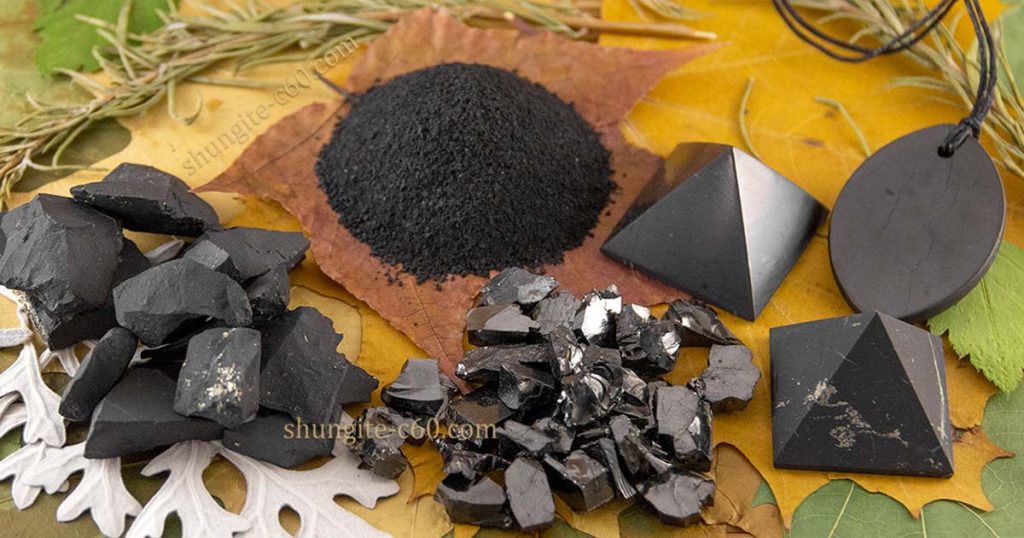
Shungite: Chemical composition
The Chemical composition table below shows the average content of the main rock-forming components in type 3. The maximum variations in the content of mineral constituents relate to CaO, Na2O, MgO, and FeO. However, the chemical and mineral composition varies depending on the physical structure of the Russian black stone. It changes due to the massiveness of shungites, fractures, the degree of brecciation, and so on.
| Chemical components | First Pack (34 samples) | Second pack (135 samples) |
| SiO2 | 32,3 | 51,6 |
| С | 37,0 | 29,2 |
| Al2O3 | 8,5 | 4,27 |
| Fe2O3 | 2,7 | 3,01 |
| FeO | 4,2 | 0,44 |
| CaO | 3,1 | 1,45 |
| MgO | 2,8 | 1,92 |
| Na2O | 2,2 | 0,18 |
| K2O | 1,0 | 1,44 |
| S | 1,9 | 1,18 |
| TiO2 | 0,6 | 0,36 |
This chemical analysis concerns the horizons of carbon-bearing rocks in the central part of the Zaonezhskaya suite. The type of geological rock section is sedimentary-volcanogenic. Members are potent zones of accumulation of organic matter of shungite. Scientists at the Institute of Geology of the Karelian Academy of Sciences performed this analysis.
Also, the thickness of the first pack bed is 160-210 meters (3 cycles of accumulation of organic matter)
The second pack occurs at a depth of 210-240 meters (6 cycles of organic matter accumulation).
What metals are in shungite?
You can see all the chemical elements, including the metals that make up the shungite stone, in the table above. Let’s decipher the chemical formula of these essential elements:
- SiO2 – Silicon Oxide
- С – Carbon (the amorphous form)
- Al2O3 – Aluminum Oxide
- Fe2O3 – Iron oxide
In this list, we have listed only the most essential chemical elements that make up the majority of shungite. But this mineral contains almost the entire periodic table. Above all, it is necessary to note that some chemical elements can harm humans, but this rock is safe for humans, animals, and plants.
In other words, everything a person consumes, water and food, also has the entire periodic table in its chemical composition. That’s why, it is essential to consider the concentration of dangerous elements. In shungite, these elements are contained several hundred or thousands of times lower than harmful norms.
Is shungite activated charcoal?
No, shungite is similar to activated Carbon but has a similar sorption capacity. Like activated carbon, it can absorb harmful impurities from water. These materials are used in water treatment systems in central urban water supply networks.
Enterprises also widely use them to purify water from various chemical contaminants. It has been scientifically proven that shunigt is superior to activated Carbon in terms of efficiency and duration of use.
On the other hand, shungite, which is the third type in its raw form, is very similar to coal. Unlike activated Carbon, Russian stone was not created artificially; on the contrary, it is a natural mineral.
Shungite fakes
The more people learn about Shungite, the more fakes appear on the market. Due to its beneficial properties and rarity, this Russian mineral has attracted the attention of many unscrupulous sellers. Counterfeit products posing as authentic rocks from Russia have appeared. Therefore, it is essential to know that not all products with a black or silver color and the Shungite inscription are such.
Fake shungite refers to minerals or artificial materials that mimic the appearance of authentic stones but do not have their properties. These imitations can be made from synthetic rubber, plastic, and orgonite. The factory-stamped forms of these fakes have an attractive appearance, but they are not shungite.
The main reason for fakes
The primary reason behind the proliferation of fakes is the market’s limited supply of authentic shungite stone. The rarity and geological specificity of genuine Russian stone make it challenging to source it in large quantities. This scarcity creates an opportunity for unscrupulous individuals to exploit the demand by selling counterfeit products that resemble rock but lack its inherent qualities.
Thus, the e-commerce market for this valuable black Karelian mineral from Russia is filled with forgeries. We want our customers to be protected from counterfeits, and we remind you that the real and only shungite stone deposit is located in our region in the Republic of Karelia, Russia.
Other deposits in other countries also have similar black rocks. But this is not a genuine Russian rock. As a result, such rocks do not have helpful and unique properties like our stones from Karelia.
One of the ways to check shungite for authenticity
This rare mineral from Karelia has a high luster, contains fullerenes, and conducts electricity. This means that the resistance of real shungite tends to zero and is practically a conductor. This mineral’s conductivity is very high and can be checked with a lamp test or a multimeter. Fakes do not have the properties of this genuinely unique mineral.
However, time and progress do not stand still, and many sellers have learned to use conductive compounds in their fakes.
Thus, to ensure the authenticity of Karelian stone, it is necessary to purchase this mineral only from a trusted manufacturer with the appropriate state Russian shungite certificates and laboratory studies results. You can get acquainted with our certificates and research results on this page. In addition, we have created a separate article in which we discussed forgeries in great detail. Learn more about fakes.
Properties of Shungite Stone
The main properties of shungite are listed at the beginning of this article. This section will discuss several more valuable properties of this rock.
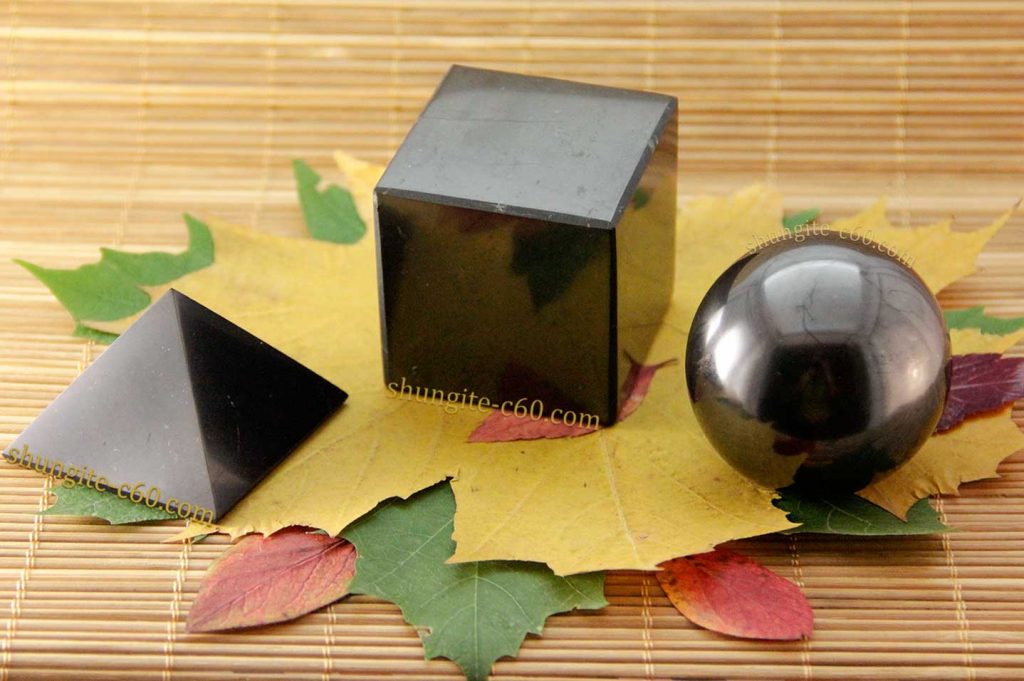
Physical Properties
The physical properties make it possible to manufacture various products from shungite. For example, tiles for protection against EmF shielding of premises, electrically conductive paints, jewelry, and souvenirs. Multiple fractions of raw black stone are used in agriculture as a mineral additive and water purification in the social sphere of human services.
Chemical properties
The chemical properties of shungite stone allow it to be used in various fields, such as:
- Catalysts in the chemical industry
- Use in filters for water purification from organic substances
- Reducing material for the chemical structure of the liquid medium
- As an additive in industry to obtain the required qualities for the products. For example, as an additive cast iron (Fe+C)
Thus, various valuable properties of shungite allow it to be used in such areas as:
- Production of building materials
- Use in the chemical industry
- Energy
- Metallurgy
- In wellness therapy
- Agriculture
- In the craft of making jewelry and souvenirs
- Water supply
- In medicine
- In the field of environmental protection
Features of use
It is also worth noting that although shungite can provide a certain level of protection against EMF, it should not be considered the only solution to minimize the effects of EMF. Responsible use of devices, such as maintaining a distance, using hands-free functions, and reducing screen time, is equally important to minimize the potential risks associated with EMF.
As with any applicable product, each person’s individual feelings may vary. We receive many positive letters from our clients saying their well-being has improved significantly since shungite appeared in their house. But we also get some reports that some of our clients feel some anxiety or anxiety when shungite is close to their bed. Thus, you should monitor your well-being and keep stone products farther from your bed.
Shungite Certification
As we mentioned earlier, the market is overflowing with fakes. In this case, it is essential to have any confirmation or guarantee of authenticity. It is important to note that these guarantees must be official and have the opportunity to be verified by official sources.
All our shungite products have a certificate of conformity by Russian legislation.
We have the results of scientific laboratory studies of our products and guarantee the authenticity of each product on our website. Many sellers can only provide paper printed on their printer at home or created in Photoshop. Such documents are not registered in the official registration resources. Our certificate is on the unified list of Russian voluntary certificates and has a unique registered number.
Who is authorized to issue certificates?
Certified shungite undergoes a comprehensive evaluation process by recognized geological institutes or independent laboratories specializing in mineral analysis. This process involves testing the stone for its carbon content, presence of fullerenes, mineral composition, and other relevant parameters.
The aim is to ensure that the certified shungite is genuine and possesses the unique properties of this remarkable mineral.
Many sellers print certificates on their printers sitting at home. But does such a certificate have value and trust?
You can have confidence in its authenticity by choosing an officially confirmed certified shungite. It eliminates the risk of falling victim to counterfeit or diluted products that may claim to be shungite stones but lack inherent qualities. The certification process is a safeguard, ensuring you purchase the real deal.
Cheap fakes and genuine products
While certified shungite may come at a slightly higher price point, its assurance of authenticity, quality, and peace of mind make it a worthwhile investment. You can be confident that you will receive genuine Karelian rock with all its extraordinary properties and potential benefits intact.
Specifics of certification in Russia
Please note that Shungite is not a product in the Russian Federation and is subject to mandatory certification. Therefore, many unscrupulous sellers from other cities in Russia or other Countries sell carbon-containing rocks under the guise of being genuine.
However, this does not mean voluntarily certifying shungite stone products is impossible. Therefore, we have made such a voluntary certification of our products. Our company cooperates with our regular customers for a long time and is ready to offer them the best quality products and guarantee the authenticity of each product.
Conclusion
So, we have come to the end of this voluminous article. We sincerely hope that you will appreciate our work. We have done a lot of work and studied a lot of Russian scientific literature to tell you about the most essential aspects of shungite. Thus, now you should have a complete idea of what shungite is. You have learned what this Russian rock is and what types it is.
In addition, you will learn about its primary and secondary properties, advantages, applications, and chemical composition. Russian stone contains a rare and unique carbon in an allotropic form called fullerene. The presence of this molecular structure endows shungite with all the abilities listed in this article.
Do not forget that only authentic certified shungite stone from Russia has these advantages. We hope all this knowledge and information will help you make the right choice and avoid unpleasant situations using fakes.
The list of scientific literature that was used to create this article:
- Clydesdale G. J., Dandie G. W., Muller H. K. Ultraviolet light induced injury: immunological and inflammatory effects. Immunology and Cellular Biology. 2001;79(6): doi: 10.1046/j.1440-1711.2001.01047.x.
- Trouba K. J., Hamadeh H. K., Amin R. P., Germolec D. R. Oxidative stress and its role in skin disease. Antioxidant Redox Signaling. 2002;4(4): doi: 10.1089/15230860260220175.
- Matsumura Y., Ananthaswamy H. N. Toxic effects of ultraviolet radiation on the skin. Toxicology Applications Pharmacology. 2004;195(3): doi: 10.1016/j.taap.2003.08.019.
- Hennessy A., Oh C., Rees J., DifB.y B. The photo adaptive response to ultraviolet exposure in human skin using ultraviolet spectrophotometry. Photodermatology, Photoimmunology, and Photomedicine. 2005;21(5): doi: 10.1111/j.1600-0781.2005.00170.x.
- Imokawa G. Recent advances in characterizing biological mechanisms underlying UV-induced wrinkles: a pivotal role of fibroblast-derived elastase. Archives of Dermatological Research. 2008;300(Supplement 1):S7–S20. doi: 10.1007/s00403-007-0798-x.
- Kwon O. S., Yoo H. G., Han J. H., Lee S. R., Chung J. H., Eun H. C. Photoaging-associated changes in epidermal proliferative cell fractions in vivo. Archives of Dermatological Research. 2008;300(1): doi: 10.1007/s00403-007-0812-3.
- Dumay O., Karam A., Vian L., et al. Ultraviolet AI exposure of human skin results in Langerhans cell depletion and reduced epidermal antigen-presenting cell function: partial protection by a broad-spectrum sunscreen. British Journal of Dermatology. 2001;
- Engel A., Johnson M. L., Haynes S. G. Health effects of sunlight exposure in the United States. Results from the first National Health and Nutrition Examination Survey, 1971-1974. Archives of Dermatology. 1988;124(1)
- Situm M., Buljan M., Cavka V., Bulat V., Krolo I., Lugović Mihić L. Skin changes in the older adults—how strong is the influence of the UV radiation on skin aging? Collegium Antropologicum. 2010;34(Supplement 2)
- Halliwell B., Cross C. E. Oxygen-derived species: their relation to human disease and environmental stress. Environmental Health Perspectives. 1994;102(Supplement 10) [PMC free article]
- McArdle F., Rhodes L. E., Parslew R., Jack C. I., Friedmann P. S., Jackson M. J. UVR-induced oxidative stress in human skin in vivo: effects of oral vitamin C supplementation. Free Radical Biology and Medicine. 2002;33(10): doi: 10.1016/S0891-5849(02)01042-0.
 Dutch
Dutch English
English French
French German
German Italian
Italian Spanish
Spanish Swedish
Swedish